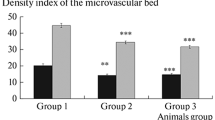The effects of dihydroquercetin (50 mg/kg intragastrically daily for 6 weeks) on the density of capillary network (mean number of capillaries per mm2), mean capillary diameter, structure of capillary network, capillary diameter distribution (<3, 3-5, 5-7, and 7-9 μ), and local cerebral blood flow (by laser Doppler) in the visual cortex were studied in SHR rats during the development of arterial hypertension (from the 6th to the 12th week of life). Normally, the systolic and diastolic BP progressively increased in SHR rats during this period. Dihydroquercetin did not affect the development of arterial hypertension. At the same time, the drug significantly increased the mean diameter of capillaries (by 11%), capillary network density (by 23%), and in the percentage of capillaries with a diameter of 3-9 μ (passable for erythrocytes; by 42%). Positive effects of dihydroquercetin on the structure of microcirculatory bed improved microcirculation: local cerebral blood flow in the visual cortex of SHR rats was significantly higher (by 36%) than in rats receiving no flavonoid and close to the value in Wistar-Kyoto rats. Dihydroquercetin improved microvascularization and microcirculation in the cerebral cortex of SHR rats during the formation of arterial hypertension.
Similar content being viewed by others
References
Bachmanov AA, Maslennikova LS, Markova LA. Changes in oxygen metabolism after active avoidance training in spontaneously hypertensive and normotensive rats. Ross. Fiziol. Zh. 1991;77(12):35-40. Russian.
Britov AN, Aparina TV. The role of “Kapilar” (dihydroquercetin) in the correction of hemodynamic and metabolic disorders in patients with atherosclerosis and arterial hypertension. Regionar. Krovoobr. Mikrotsirk. 2006;5(2):46-53. Russian.
Zhuravlev DA. Models of arterial hypertension. Spontaneously hypertensive rats. Arterial. Gipertenz. 2009;15(6):721-722. Russian.
Novitskii VV, Rezavtseva NV, Stepovaya EA. Physiology and Pathophysiology of Erythrocyte. Tomsk, 2004. Russian.
Plotnikov DM, Aliev OI, Maslov MYu, Tyukavkina NA, Plotnikov MB. The effect of antioxidative complex on hemorheology and lipid peroxidation in patients with arterial hypertention. Tromboz, Gemostaz, Reologiya. 2001;(3):44-47. Russian.
Plotnikov MB, Tyukavkina NA, Plotnikova TM. Diquertin-Based Drugs. Tomsk, 2005. Russian.
Plotnikov MB, Aliev OI, Anishchenko AM, Sidekhmenova AB, Shamanaev AYu, Fomina TI. Parameters of cerebral cortex capillary network in SHR rats during the development of arterial hypertension and stable high blood pressure. Ross. Fiziol. Zh. 2016;102(5):558-566. Russian.
Tokhomirova IA, Murav’ev AV, Petrochenko EP, Mikhailova SG. Microcirculation and Blood Rheology in Circulatory Disorders. Yaroslavl, 2011. Russian.
Feihl F, Liaudet L, Waeber B, Levy BI. Hypertension: a disease of the microcirculation? Hypertension. 2006;48(6):1012-1017.
Hadaegh F, Mohebi R, Khalili D, Hasheminia M, Sheikholeslami F, Azizi F. High normal blood pressure is an independent risk factor for cardiovascular disease among middle-aged but not in elderly populations: 9-year results of a population-based study. J. Hum. Hypertens. 2013;27(1):18-23.
Jung F, Pindur G, Ohlmann P, Spitzer G, Sternitzky R, Franke RP, Leithäuser B, Wolf S, Park JW. Microcirculation in hypertensive patients. Biorheology. 2013;50(5-6):241-255.
Murfee WL, Schmid-Schönbein GW. Structure of microvascular networks in genetic hypertension. Methods Enzymol. 2008;444:271-284.
Plotnikov MB, Aliev OI, Maslov MJ, Vasiliev AS, Tjukavkina NA. Correction of the high blood viscosity syndrome by a mixture of diquertin and ascorbic acid in vitro and in vivo. Phytother. Res. 2003;17(3):276-278.
Tsioufis C, Dimitriadis K, Katsiki N, Tousoulis D. Microcirculation in Hypertension: An Update on Clinical Significance and Therapy. Curr. Vasc. Pharmacol. 2015;13(3):413-417.
Zicha J, Kunes J. Ontogenetic aspects of hypertension development: analysis in the rat. Physiol. Rev. 1991;79(4):1227-1282.
Author information
Authors and Affiliations
Corresponding author
Additional information
Translated from Byulleten’ Eksperimental’noi Biologii i Meditsiny, Vol. 163, No. 1, pp. 69-72, January, 2017
Rights and permissions
About this article
Cite this article
Plotnikov, M.B., Aliev, O.I., Sidekhmenova, A.V. et al. Dihydroquercetin Improves Microvascularization and Microcirculation in the Brain Cortex of SHR Rats during the Development of Arterial Hypertension. Bull Exp Biol Med 163, 57–60 (2017). https://doi.org/10.1007/s10517-017-3737-7
Received:
Published:
Issue Date:
DOI: https://doi.org/10.1007/s10517-017-3737-7



